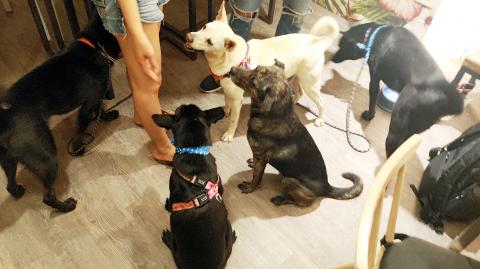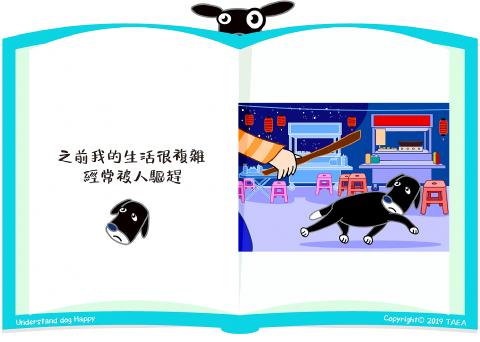When The PACK Sanctuary had two corgis dumped on them earlier this month, they were able to adopt them out in less than a week. For the remaining 300 or so mostly mixed-breed Taiwanese dogs at the shelter in New Taipei City’s Sanjhih District (三芝) though, the story isn’t so rosy.
With Taiwanese generally preferring to purchase smaller animals or trendy pooches such as red poodles, shibas and corgis, shelters around Taiwan are full of these mixed tugou (土狗), often black ones, as well as other less favorable breeds, that languish there year after year.
“We provide as much space and enrichment as we can, but with 300 dogs and so little resources, sadly the human-animal bond gets lost,” The Pack CEO Tim Gorski says. “Shelter life is not living; it’s existing.”

Photo courtesy of The Pack Sanctuary
When Taiwan Animal Equality Association (台灣動物平權促進會, TAEA) published an illustrated e-book earlier this year on treating a dog like it’s one of the family, it elected to feature a white-footed black tugou named “Happy” (黑皮) as its protagonist.
“We specifically wanted to feature the color combination that’s the hardest to adopt out due to traditional superstitions,” TAEA CEO Lin Yi-shan (林憶珊) says. “We wanted to let our audience know that these mixed-breed Taiwanese dogs are also very adorable.”
THE TUGOU PROBLEM

Photo: Han Cheung, Taipei Times
Most mixed tugous trace their lineage back to the Taiwan Dog, or Formosan Mountain Dog, who were used by Aborigines as hunting companions. Lee Chao-chuan (李朝全), chairman of the Animal Protection Association of the Republic of China (中華民國保護動物協會), says that as Taiwan’s economy took off in the 1950s, people started importing large foreign canines such as golden retrievers and German shepherds.
This problem persists today, where people tend to buy whatever dog breed is popular at the moment without considering whether they can care for the dog or whether the dog is suited to Taiwan’s environment. Due to a lack of pet care and ownership awareness, people do not know how to handle or train their best friend and often end up abandoning it.
Over the years, these numerous abandoned or escaped dogs crossbred with the Taiwan Dog, leading to the proliferation of mixed breed tugous that are common today. In fact, it’s hard to find a purebred Taiwan Dog these days, Lee says.

Photo: Han Cheung, Taipei Times
Besides the stereotypical perception of them as dirty, disease-infested street animals, another reason they’re not popular is that they’re too large for the typical urban Taiwanese household and need a great deal of exercise and care.
“Taiwanese don’t like the color black, so black mixes are especially unfavorable,” Lee adds.
“Red is auspicious, for example, so people like red poodles. They are also less aggressive.”

Photo courtesy of The Pack Sanctuary
Liu Su-fen (劉素芬), founder of Precious Dogs Association (寶貝狗協會) says that in fact, mixed-breed dogs are generally healthier than purebred dogs, many of whom have various congenital health problems.
“Every dog to me is a perfect dog,” Liu says. “But people still feel that only certain breeds are ‘good.’ This shows that Taiwan is still severely lacking in education about pet ownership and animal protection. Most people still treat them simply as animals instead of a family member.”
AMERICA BOUND

Photo courtesy of Taiwan Animal Equality Association
The PACK is trying new ways to reduce its shelter population to free up resources to educate the public about the importance of adopting rescue dogs.
Last month, Jessamy Chiang (江梵熙) inspected five mixed tugous that have been with The PACK for between three and eight years to make sure they’re suitable for adoption. Chiang is the managing director of Asians for Humans, Animals and Nature (AHAN), a San Francisco-based organization that has been adopting out unwanted stray or shelter dogs from Taiwan to homes in California for the past two decades.
The state has been a forerunner in animal rights, banning puppy mills in 2017 and earlier this year mandating that pet shops only sell animals that are rescues or come from shelters.
In June, The PACK sent three dogs through AHAN to San Francisco. Gorski, who has worked in animal protection in Asia for the past 15 years, was initially adamant that he would not “send Asia’s problems to the US.”
But according to the study, “Dog Population and Dog Sheltering Trends in the USA,” published last year, the percentage of owned dogs that were adopted from shelters and rescues increased from 15 percent to over 35 percent in just 10 years.
Gorski says that due to the increase in adoption rates in the US, especially California, the dogs remaining in shelters often have severe behavioral problems and are considered unadoptable. Meanwhile, there are perfectly adoptable tugous and other breeds that simply don’t fare well in Taiwan who are stuck in shelters.
The dogs that passed Chiang’s inspection will not be sent overseas right away — they will be moved from the shelter to a temporary home for a month where they are trained and acclimatized to living indoors. Then it’s screening applicants to find a suitable home for them.
Animal protection organizations agree that this is not the solution. But education takes time, and Liu says that it might even take a few generations for attitudes to fully change.
“There’s still a long road to go before people here start treating all types of dogs equally,” she says.

A vaccine to fight dementia? It turns out there may already be one — shots that prevent painful shingles also appear to protect aging brains. A new study found shingles vaccination cut older adults’ risk of developing dementia over the next seven years by 20 percent. The research, published Wednesday in the journal Nature, is part of growing understanding about how many factors influence brain health as we age — and what we can do about it. “It’s a very robust finding,” said lead researcher Pascal Geldsetzer of Stanford University. And “women seem to benefit more,” important as they’re at higher risk of

March 31 to April 6 On May 13, 1950, National Taiwan University Hospital otolaryngologist Su You-peng (蘇友鵬) was summoned to the director’s office. He thought someone had complained about him practicing the violin at night, but when he entered the room, he knew something was terribly wrong. He saw several burly men who appeared to be government secret agents, and three other resident doctors: internist Hsu Chiang (許強), dermatologist Hu Pao-chen (胡寶珍) and ophthalmologist Hu Hsin-lin (胡鑫麟). They were handcuffed, herded onto two jeeps and taken to the Secrecy Bureau (保密局) for questioning. Su was still in his doctor’s robes at

Last week the Democratic Progressive Party (DPP) said that the budget cuts voted for by the China-aligned parties in the legislature, are intended to force the DPP to hike electricity rates. The public would then blame it for the rate hike. It’s fairly clear that the first part of that is correct. Slashing the budget of state-run Taiwan Power Co (Taipower, 台電) is a move intended to cause discontent with the DPP when electricity rates go up. Taipower’s debt, NT$422.9 billion (US$12.78 billion), is one of the numerous permanent crises created by the nation’s construction-industrial state and the developmentalist mentality it

Experts say that the devastating earthquake in Myanmar on Friday was likely the strongest to hit the country in decades, with disaster modeling suggesting thousands could be dead. Automatic assessments from the US Geological Survey (USGS) said the shallow 7.7-magnitude quake northwest of the central Myanmar city of Sagaing triggered a red alert for shaking-related fatalities and economic losses. “High casualties and extensive damage are probable and the disaster is likely widespread,” it said, locating the epicentre near the central Myanmar city of Mandalay, home to more than a million people. Myanmar’s ruling junta said on Saturday morning that the number killed had